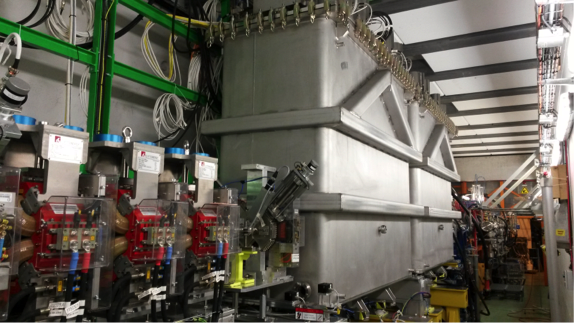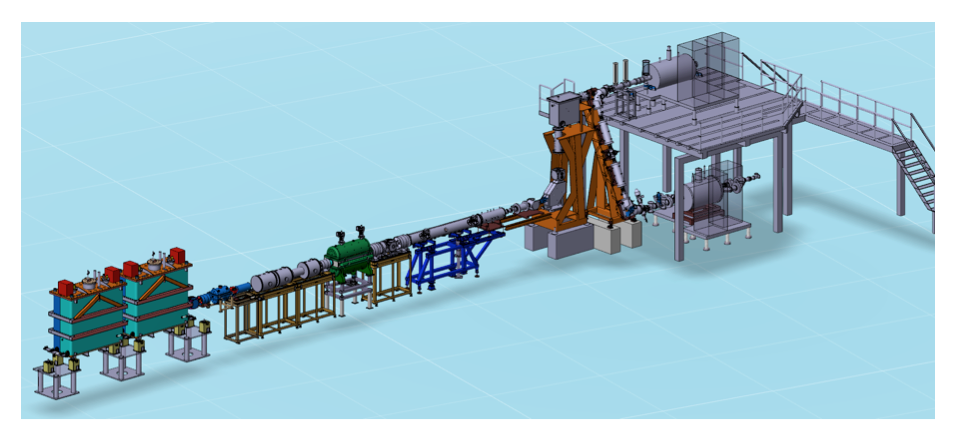HIE-ISOLDE: Stage 1 fully installed
ISOLDE is CERN’s radioactive beam facility that produces low energy and post-accelerated beams. The high energy and intensity, average intensity of 2 μA, of the proton beam from the PS booster on different thick targets produces high quality intense beams of rare nuclei. The ISOLDE facility at CERN offers the largest selection of ISOL-beams worldwide with more than 1000 different isotopes of 75 chemical elements.
The High Intensity and Energy at ISOLDE, HIE-ISOLDE, project intends to improve the experimental capabilities at ISOLDE over a wide front. The impact of the increase of energy and intensity of the injectors together with improvements in several aspects of the secondary beam properties such as purity, ionisation efficiency and optical quality are addressed in the HIE-ISOLDE Design Study. Its implementation will be done gradually. A new physics domain will be accessible from the increase of energy of the post-accelerated beams. The plan is to boost the energy of the beams, going in stages from the previous energy of 3 MeV (REX-ISOLDE) via 5.5 MeV to finally 10 MeV per nucleon (MeV/u) for radioactive ion beams of A/q up to 4.5, by first extending and later replacing the 7-gap and 9-gap with superconducting quarter-wave resonator cavities. The aim is to achieve full energy variability from 0.3 MeV/u to 10 MeV/u and operational flexibility while maintaining beam quality and keeping a very compact linac design compatible with the existing ISOLDE building.

The major component to boost the energy of the post-accelerated beams is the addition of a new superconducting (SC) linear accelerator (HIE-linac) based on Quarter Wave Resonators (QWRs) with twenty high-b cavities cooled by helium and installed in four cryomodules. The HIE-linac upgrade is staged to deliver higher beam energies to the experiments as soon as possible. The first stage involves the design, construction, installation and commissioning of the first two cryomodules downstream of REX. We report here on the completion of the first stage of the HIE-ISOLDE project approved by CERN in September 2009. We expect the first radioactive beam with up to 5.5 MeV/u for A/q = 4.5 at the end of August. We plan to celebrate the completion of phase 1 at CERN the 28th of September.
Each cryo-module contains five cavities and one solenoid. Due to the limited space it has been necessary to design and build accelerating cavities with a very high voltage gradient of 6 MV / m and low heat dissipation below 10 W. The high-b cavities used at ISOLDE adopted a technology based on copper cavities sputter-coated with niobium. The technique was invented at CERN for the cavities of LEP [C. Benvenuti et al., Appl. Phys. Lett. 45 (1984) 583]. The ISOLDE cavity design follows the technique developed later at Legnaro to accelerate heavy ions at the ALPI linac [V. Palmeri et al., PAC1991]. A stainless steel vacuum vessel contains five cavities and a solenoid surrounded by a thermal screen, which is actively cooled with helium at 50 K. In order to minimise the drift length between cavities and the overall length of the machine a common vacuum was chosen for the beam and cryogenic insulation. Although the major challenge was to produce cavities achieving the required performance, the assembly of the cryomodule also presented a challenge. Unlike the LHC cryomodules, for example, in which the internal surfaces of the cavities are isolated from the other components, all the elements of the HIE-ISOLDE cryomodule are located in the same vacuum. The cryomodule is therefore more compact, which is essential given the limited space in the ISOLDE building.
A new high-energy beam transfer line brings the post-accelerated beams to the experiments. Presently two identical beam lines at 90 degrees to the transfer line have been operative for physics since 2015. A third one will be mounted in the winter shutdown of 2017 to accommodate the ISOL Solenoidal Spectrometer, ISS, until the storage ring, TSR, will be coupled to HIE-ISOLDE.
The first cryomodule was ready at the beginning of 2015 and the first radioactive beams were accelerated to 4 MeV/u in the autumn of 2015. First studies were dedicated to explore the shell evolution in the vicinity of the spherical nucleus 68Ni, by performing Coulomb excitation studies in 74,76Zn on heavy targets. In this region adding neutrons beyond N=40 leads to a rapid increase of collectivity, with a challenging interplay of both collective and single-particle degrees of freedom. Such rapid changes indicate underlying complex effects and make the region ideal for testing theoretical calculations. The results obtained, even if the conditions were far from ideal, demonstrate the importance of reaching higher beam energies which allowed for the population of higher spin states with sizable cross sections opening in this case the possibility of multi-step Coulomb excitation.

Fig. 1: 3D-view of the post-accelerator at ISOLDE as it looks in 2016. It combines the exiting REX-linac with two superconducting cryomodules with a total of 10 QWR cavities to boost the energy to 5.5 MeV/u for A/q = 4.5
During the shutdown of 2016, as part of HIE-ISOLDE stage 1, the second cryo-module has been added to the SC Linac, see photo of the descent of the cryomodule to be coupled to the HIE-linac, and fig. 2 for a photo taken at the end of April 2016 showing the two cryomodules coupled to the linac. In parallel with the commissioning of CM1 and CM2 in the ISOLDE facility, the assembly of the remaining two high–β cryomodules (CM3 and CM4) for the phase 2 of the HIE-ISOLDE energy upgrade is on-going. One cryo-module will be added in 2017 prior to the experimental campaign and the fourth one at the beginning of 2018 in order to reach the expected 10 MeV/u for A/q = 4.5 during the full year before LS2.
To prepare for the physics campaign with post-accelerated beams at 5.5 MeV/u a workshop was held (https://indico.cern.ch/event/462504/) on the 1st of February 2016 with more than 50 participants. There 75% of the approved experiments were represented expressing their interest in running this year. More importantly they demonstrated that the physics case was still relevant and of great interest. We expect to start with experiments at the end of August after the commissioning of the HIE-linac that is already quite advanced. Presently the beam time schedule has been released and seven experiments out of the thirty discussed in the February Workshop have been scheduled. The first one is the study of 59Cu(p,a) cross section and its implications for nucleo-synthesis in core collapse supernovae. This experiment constitutes the first opportunity to measure this key reaction at astrophysical burning energies. This experiment will be performed in the second beam line. Then we will continue with multi Coulomb excitation studies near the double magic nuclei 78Ni, 100Sn and132Sn in the first beam line. Transfer reaction studies at the neutron drip line will explore resonant states and the dipole resonance in the halo nuclei 11Li. This experiment will be performed at the energy of 7 MeV/u available at HIE-ISOLDE stage 1 for A/q = 3, and feasible for light nuclei. The campaign will close with the study of statistical properties of warm nuclei. The enhancement of gamma strength observed at low energies in stable nuclei if confirmed in exotic nuclei will have an effect in neutron capture cross sections in astrophysical scenarios. We are looking forward to this HIE-exciting period
